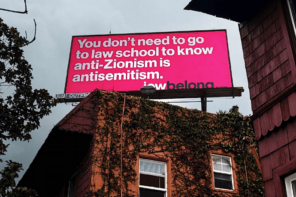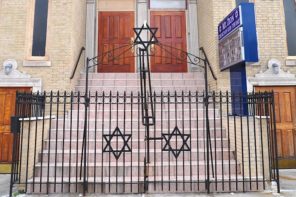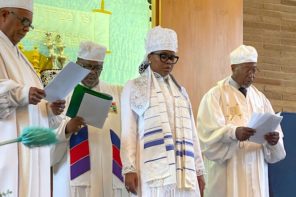I am the child of an interfaith marriage, and the parent of interfaith teenagers. My husband and I chose to educate our children in both Judaism and Christianity. And we are not alone. According to a recent Pew report, 25% of intermarried Jews are raising children “partly Jewish by religion and partly something else.” This translates to an estimated 300,000 children being raised with two religions.
Am I “partly Jewish”? I am Jewish, despite the fact that as a patrilineal Jew (with a Christian mother) I’ve had to defend my Jewish identity to my fellow Jews throughout my lifetime. I’ve given up waiting for agreement on that eternal question, “Who is a Jew?” Instead, I claim Judaism for myself and for my children—claim the right to be whole, rather than fractionated, or fractured.
Simultaneously, I claim the “interfaith” label—the synergy produced by the confluence of religious cultures, and immersion in the commonalities, differences, and entwined histories of Judaism and Christianity. Rather than defining me as a “partial” or “half” Jew, the interfaith label gives equal weight to both sides of my heritage.
I understand but resist the way the discourse on interfaith families has been dominated by panic over Jewish continuity. Increasingly, the “other” parent in an interfaith family may also represent a vibrant minority, whether Greek Orthodox, Buddhist, Pagan, Muslim, Hindu, or humanist. Judaism does not get to “win”—to strong-arm or guilt these spouses into giving up their beliefs—based on its traditional underdog status.
In Being Both: Embracing Two Religions in One Interfaith Family, I chronicle a grassroots movement to provide interfaith education for interfaith children. In interfaith family communities in Chicago, New York, and Washington, Jewish and Christian educators are working side by side in dual-faith classrooms, comparing and contrasting, and noting points of historical connection. They teach texts and rituals and history, not creed or dogma.
In response to the Pew report, Jewish leaders continue to express concern that such interfaith children will break the chain of Jewish continuity. In a recent essay, Jack Wertheimer, a longtime opponent of interfaith marriage, acknowledged the existence of interfaith family communities, predicting that “Jews-for-Jesus and other messianic groups will undoubtedly be the beneficiaries of these efforts, and synagogues will find themselves pressed to adopt religiously syncretistic practices in order to accommodate those with hybrid identities.”
This prediction betrays a profound misunderstanding of how interfaith education programs operate, and how these interfaith children “turn out.” None of the teens and young adults I surveyed or interviewed have become Jews for Jesus, a conservative evangelical form of Christianity. Typically, they see Jesus as an important teacher, a rebel rabbi, a mystical paradox, a Zen koan, but not as a messiah or personal savior. In terms of theology, many of these interfaith children could be characterized as Jews with an unusual knowledge and appreciation of Christianity, or progressive Christians with an unusual knowledge and appreciation of Judaism. My contention is that either of these identities is good for Judaism, and good for the world.
As for expecting synagogues to adopt “syncretistic practices,” the opposite is true. Interfaith children want access to an inspiring Judaism, whether they choose Judaism, or whether they continue to draw from both religions. It remains essential, for the world and for interfaith children, to preserve the specificity and particularity of each religion. At the same time, I agree with Orthodox rabbi Brad Hirschfield, who wrote a recent essay pointing out that all religions are ultimately syncretic, and that “Syncretism is simply the word for a religious borrowing project whose success is not yet assured, which ultimately doesn’t gain popular support, or which some current religious authorities don’t like.”
In the 2011 study of the Jewish population of New York, sociologist Steven M. Cohen found that 12% of the adult New York Jewish community now identifies as “partially Jewish.” Cohen refers to adult interfaith children as part of the “borderland Jews,” a term with a kind of Wild West flair that appeals to my rebellious side; but again, a term that only references half of my heritage can only be half-right.
Meanwhile, Catholic academics have been writing for years about “multiple religious-belonging.” Theologian Paul F. Knitter’s book, Without Buddha, I Could Not Be a Christian, explores how he draws on both Christianity and Buddhism. Peter Phan at Georgetown notes that, in Asia, “multiple religious belonging is a rule rather than an exception, at least on the popular level.” And while she ultimately disapproves of this, Catherine Cornille, at Boston College, writes, “More and more individuals confess to being partly Jewish and partly Buddhist, or partly Christian and partly Hindu, or fully Christian and fully Buddhist.” Some of these theologians warn that complex identities may be “shallow” if claimed not by scholars but by “dilettantes.” And yet, can a child immersed in two religions from birth be a dilettante?
Is weak faith, or religious disengagement, the necessary corollary of learning two religions from birth? In the past, interfaith families may have celebrated Hanukkah, Christmas, and little else. Jewish families sat shiva for their intermarried children. Religious communities excluded them. Many of these families, if they couldn’t choose one religion, had little choice but to become religious minimalists, or religious “nones.”
In contrast, over this fall, our family observed Rosh Hashanah and Yom Kippur, Sukkoth and Simchat Torah, with our interfaith families community. Our Jewish practice is both religious and spiritual, not simply cultural. But we also celebrated the Blessing of the Animals, inspired by Saint Francis.
In the Pew study, researchers noted that interfaith children view their religious identity as “uncertain.” In my book, I give voice to these children, based on years of surveying, interviewing, and observing teens and young adults educated in interfaith programs.
These young interfaith adults experienced interfaith education not as a compromise, but as an inspiration. They see themselves as bridge-builders and peacemakers in a world marred by religious intolerance and violence. In my survey, the typical product of interfaith education is not confused, and feels that his or her parents made a good choice in choosing dual-faith education. These teens and young adults also continue to feel connected to Judaism, and to stand up for the Jewish people. And most of them intend to pass on Judaism (as well as Christianity) to their own children.
Sadly, some interfaith families must struggle to gain access to Jewish knowledge. Even in Reform Judaism, the official policy is to refuse to educate children who formally study more than one religion. This has created an untenable “Don’t Ask, Don’t Tell” situation in synagogues that know families are educating children in both religions, but expect these families (including children) to keep quiet about it. One girl I spoke with belonged to a synagogue but was raised with both Judaism and Catholicism. The granddaughter of a Holocaust survivor, she was told that she could use the sanctuary for her Bat Mitzvah, but not the Torah or the rabbi. Her mother asks, “In the name of religion, for a child who wants to do this, you’re going to turn a child away?”
I am a journalist, not a social scientist. I invite demographers, sociologists, psychologists and professors of religious studies to follow up with academic research on interfaith children. But based on my own reporting, Jewish institutions may want to reconsider the strategy of trying to stop families from educating their children in more than one religion. I see this as a misguided gamble for the survival of institutional Judaism in its current form.




